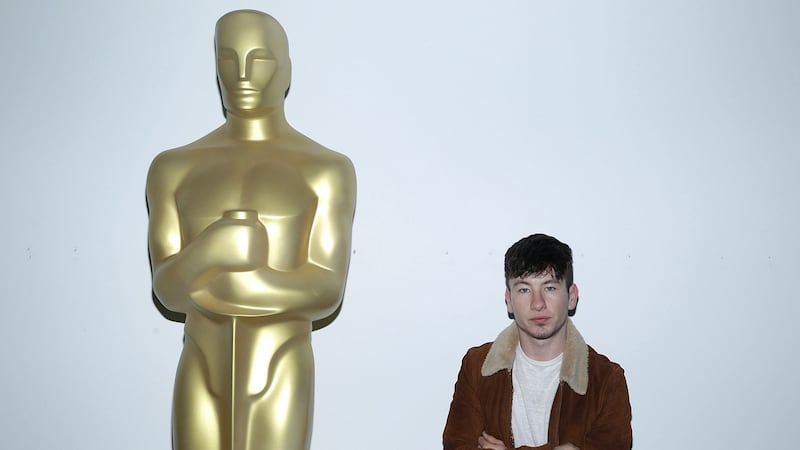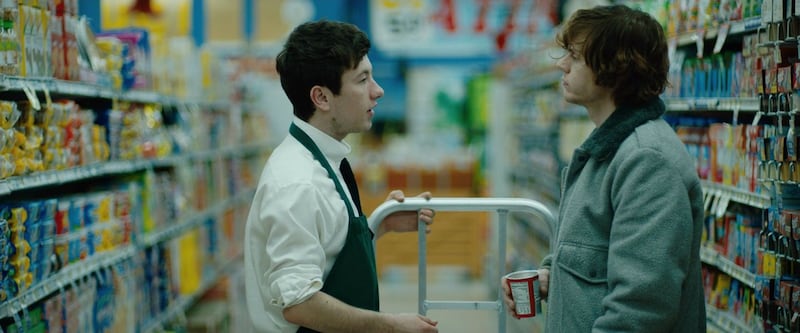Pressures come with being the Next Big Thing. There may be even greater pressures associated with a subsequent move to Established National Treasure. Barry Keoghan, at only 25, is on that journey. It is only seven years since he made his screen debut in Mark O'Connor's Between the Canals. It is just five (really?) since he joined the star-mining machinery of Love/Hate.
But the fidgety, sharp-faced actor already seems to be occupying every worthwhile corner of the entertainment industry. This month alone, you can see him in American Animals, a true-crime heist movie, and Lance Daly's famine epic, Black 47. They'll soon be naming streets after him in Summerhill.
“With this acting and this lifestyle, your privacy does get taken a little,” he says with a fatalistic shrug. “But I am not on the scale where I can’t walk down the street. I will pose for a photo and that’s nice. It’s not become like you need a security guard. Yet. Ha ha!”
It helps that Keoghan, a proud defender of Dublin’s northside, has a story to tell. He’ll be forced to tell it for the rest of his career. He was born into a community ravaged by heroin addiction. His mother died of an overdose when he was a child and, after time in various foster homes, he was taken in and raised by an indomitable grandmother.
You know the Dublin smell? I am not even messing. I'm telling you
He’ll talk about that and, while acknowledging the trauma, make a point of stressing the light among the shade. A cackler with a great line in self-deprecation, he’s never likely to write a self-help book, but he does accept that his early traumas generated coping mechanisms.
“Yeah. Not only for this business,” he says. “But that builds a certain amount of solidness. I have been through it. Not to say my experiences are different to anybody else growing up. But the way I went through it really wasn’t nice. And that does make you a solid man. It makes you deal with things a lot better.”
Keoghan is an inveterate joker. That much-circulated photograph of him cracking up Prince Harry – while Caitriona Balfe and Moe Dunford look on equally amused – sums up one side of him. But the thoughtfulness is never too far from the surface. He's serious about work and he's serious about honouring his bumpy upbringing. Encouragingly, he has told no horror stories about his time in foster care. He has been full of praise for the families who took care of him.

“Yeah, all my foster homes were very good to me,” he says. “But it’s still not a very nice experience. It’s only when you’re older, you realise: we were on our own in there. As kids you don’t know what’s happening. You’re here. Then you’re in the next house. But the families were all very good to us. And anybody I’ve talked to has felt the same. I know years ago the families were sometimes split up, but me and my brother were lucky enough to stay together.”
He's been around in recent years. He shot The Killing of a Sacred Deer and American Animals in the US. He really did get damp in the seas of northern Europe while shooting Dunkirk. But he takes as many opportunities as possible to walk the old streets. I wonder if he feels the heroin problem has improved.
“Back then, when it caught a lot of families, it was worse,” he says. “It was a new drug. It was a new thing and people didn’t know the effects. I think people are now more aware of it. That’s not to say that people aren’t still struggling. There are a lot of people still struggling. I don’t think it’s gone yet. But there are not as many people on it.”
What does he miss most about the city when he’s sunning it in LA or skipping the red carpet at Cannes?
"The smell of it!" he says without pause (before going on to sound even more like Colonel Kilgore in Apocalypse Now). "You know the Dublin smell? I am not even messing. I'm telling you."
It was Between the Canals that got Keoghan properly snared in the acting mesh. Mark O'Connor, now best-known for his breakout hit Cardboard Gangsters, saw something special in the young, energetic performer. "It started when I put an ad in a window in Sheriff Street, looking for actors in the area," O'Connor told me recently. "He must have been ringing me for two or three years. Every week I'd get a phone call."

Keoghan remembers getting involved with a school play at Christmas and then having that “taken away” from him for misbehaving.
“I thought: that’s my acting career over,” he says. “It was definitely Mark. There was something about the camera there. You could hide behind the camera. It was therapeutic. I was working through emotions and telling a story. That was when I got a feeling and taste for it.”
Between the Canals barely secured a release, but critics admired its singular energy and it served as a persuasive calling card. In 2013 he secured a role on Love/Hate and, after his character notoriously killed that cat, he found his face scattered liberally about the tabloids. A horse could tell that the kid had talent and charisma. But not every talented Dubliner makes it on to the bigger stage. Roles in Yann Demange's '71 and Rebecca Daly's Mammal pushed the profile a little further above ground.
If the character is Russian, I am Russian. If he's English, I'm English. You have to immerse yourself in that world
International recognition came last year when he appeared as a flattened psychopath in The Killing of a Sacred Deer and as an accidental hero in Dunkirk. The former cast him alongside Colin Farrell. In the latter he shared scenes with Cillian Murphy.
“It’s more inspiring than being star-struck,” he says. “Colin has been very inspiring. He made a huge impact on what I think and how I act. Getting to act with him was important. And Cillian too. Without wanting to make them feel old, growing up I looked at them and thought: maybe I could do that. These lads opened the way for me. And they are even better people than they are actors.”
Observing his performances in Sacred Deer and American Animals, one is struck by how convincingly he can shift continents. Some British and Irish actors (including a few who've won Oscars) never manage to seem properly American. But his disillusioned college student in American Animals has not a trace of Dublin in him. The accent is strong. The posture is good, too. The actor Charlie Plummer told me that, when preparing Sacred Deer, Keoghan got him to record tapes of his voice that the Irish man would listen to when perfecting his vowels.
“I am always an Irish man, Donald. Ha ha! I always have a green heart under there,” he says. “But if the character is Russian, I am Russian. If he’s English, I’m English. You have to immerse yourself in that world. Yeah, I do reach out to lads that I know who are my age: people like Charlie Plummer or Timothée Chalamet.”

And it’s not just about the voice?
“No, you’re dead right. The posture and everything changes. It’s our job to spot that. We’re the experts on figuring out other humans, on reading body language. I do study that. I see how they hold themselves: from a Kentucky boy to a New York boy. They hold themselves completely different. It’s the same as a Kerry man and a Dublin man. Obviously we’re much better!”
American Animals is based on the true story of a heist that, in 2004, saw a bunch of students lift invaluable Audubon manuscripts from a university in Kentucky. The film offers one sort of truth to audiences. Bart Layton, the gifted director of The Imposter, approached the material as if making a documentary. "He didn't want us mixing with the real-life dudes because they might have an influence: 'I wasn't that mean. I wasn't that violent. I was a bit funnier,' " Keoghan remembers.
Black 47 offers another sort of truth. Lance Daly's picture, framed as a class of drizzly western, cleverly works in endless details about the outrages that attended the Famine. I wonder if, travelling the US and Europe, he has any sense that outsiders understand the still-controversial history.
"It's totally new to them," he says. "To many Irish people it is new. Even to me to an extent. Getting involved with Black 47 was like getting involved with Dunkirk for me. I learned a lot. But Black 47 was my own history from my own country. I should know more and I didn't."
There's much more. Right now he is shooting the pilot for a TV adaptation of DC's post-apocalyptic comic Y: The Last Man. Keoghan has secured the lead role of Yorick. Feel the rush of that momentum. His mum would surely have been proud. I wonder if she would ever have expected it.
“I always put a smile on her face,” he says. “But yeah. It would be a surprise. I had no sense of doing acting until the time of 16 or 17, and she was gone by then.”
He makes a noise a little like a sigh.
“She’d be pretty proud.”
FIVE GREAT HEIST MOVIES
American Animals offers a fresh, comic take on the heist genre. It’s an inexhaustible form. Here are five more that got away with the loot.
Rififi (1955)
Following his blacklisting, Jules Dassin – from Connecticut despite his exotic name – travelled to France and shot this thrilling tale of a jewel heist on the Rue de Rivoli.
The Killing (1956)
Stanley Kubrick's third feature was not a hit at the time, but the bleak cool thriller – following the attempt to rob a racetrack – has cast a long, grey shadow.
The Italian Job (1969)
Peter Collinson's picture is, in many ways, an awful mess, but it came to represent a certain class of swinging English exuberance. Minis. Michael Caine. Benny Hill. Noel Coward.
Reservoir Dogs (1992)
Arguably Quentin Tarantino's best film. Certainly his most disciplined. Among many innovations, the picture shows only the prelude to and aftermath of the jewel heist.
Heat (1995)
Is Michael Mann's most realised film really a heist flick? Well, it leads up to a robbery and the eventual showdown results from that robbery. So, yes. The best shoot-out in 1990s cinema.





















